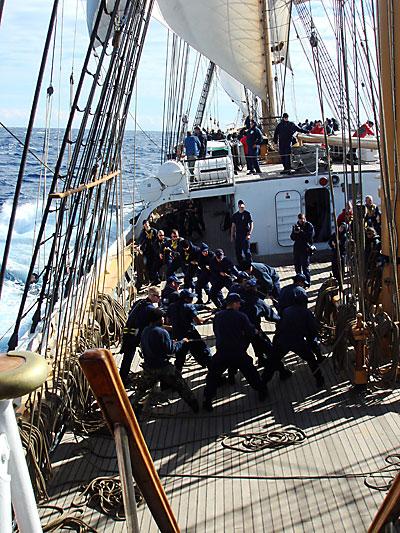Under Sail on America’s Tall Ship

Log entry, April 15, 0800, entering the Gulf of Mexico
Eagle’s crew at attention on the waist swaying in unison to the ship’s motion like wheat in the wind. Flying fish flee our wake, their silver sides flashing in the morning sun. They must be nature’s most hopeful creatures, the way they flee their natural element to escape, not unlike sailors.
Yesterday, a 278-foot Coast Guard cutter passed us going the other way toward Key West with a number of Cuban refugees whom a smaller cutter had intercepted. They will be processed and flown back to Havana.
Admiral Chuck Michel of the Joint Inter-Agency Task Force South has joined Eagle. The head of drug-interdiction efforts, he hasn’t been on her deck since his academy days. He climbed to the main cross-trees yesterday to become reunited. He talked of cocaine’s destructive power. “Eats at the fabric of society. It’s not the growers’ problem, it’s ours,” he said of our nation’s demand.
His aide is an Army major who said his wife told him to take care because he’d made it out of Iraq alive.
Oil rigs in the distance. The ghost of BP’s Deepwater Horizon. New Orleans and the ghost of Katrina. The Coast Guard’s prominent role in both disasters.
Capt. Eric Jones tells the crew to gather ’round. He reads a message he’s received from Admiral Robert Papp, former Eagle captain and now the Coast Guard’s commandant. The message reveals the names of the two coasties shot and killed in Kodiak, Alaska, yesterday for reasons unknown. A number of officer candidates aboard have served in Kodiak.
“Our job is too difficult for this kind of thing to happen.” Their families will need help and our prayers, Captain Jones says.
Increasing wind out of the southeast. Eagle sails under courses, her four headsails, staysails, upper and lower topsails. T’gallants and royals will be set after quarters.
* * *
The United States Coast Guard’s sail training ship Eagle will turn 76 in June. On April 17, she arrived in New Orleans after a 10-day passage from New London. This summer, she will visit ports along the Gulf and East Coasts as part of a bicentennial commemoration of the War of 1812 and will train Coast Guard Academy cadets in the process. New York, New London, Conn., Boston, Newport, R.I., and Greenport are on her schedule.
Eagle will be joined by other vessels involved in Operation Sail. OpSail is a not-for-profit sponsor of fleet gatherings and parades of sail in ports around the world since 1964.
In New Orleans, Eagle tied up just off Canal Street in the French Quarter alongside two other school ships, the Guayas from Equador, a barque like Eagle, and Dewaruci from Indonesia, a barkentine.
There is always a large turnout when Eagle docks and offers up her weather deck to visitors, who learn she was built as a training ship by Hitler’s Germany in 1936, that the Coast Guard took her as a war prize, that she is just under 300 feet long with a beam of 39 feet. She was built of Krupp steel in the tradition of the last commercially viable sailing ships that carried bulk cargo, like wheat and guano, in the late-19th and early-20th centuries.
She trains future Coast Guard officers and petty officers in seamanship, teamwork, navigation, and most important — her captains like to stress — engenders humility. The sea is foreign and powerful and yet there are ways to live with it, but only if one first confronts and accepts its superiority.
Eagle, and the very few remaining ships like her, was built to live with the sea using a language and technology that took centuries to perfect. She’s called America’s Tall Ship, and those who visit her when she’s tied to a dock, her sails furled, cocooned, can be forgiven for viewing her as a kind of ornamental re-enactment. She is not.
When Eagle emerged from the dockside chrysalis soon after leaving New London — it takes more than 60 people and upward of an hour to set Eagle’s sails depending on the saltiness of the crew — she came alive.
It’s hard to think of a 1,784-ton assemblage of steel, cable, miles of rope, and 22,300 square feet of Dacron cloth as a living thing, but there is no other way to put it, especially as she approaches her 17-knot hull speed pressing over and through six-foot seas, her deck a gracefully rolling hillside.
There’s a feeling that life’s many challenges, shoreside entanglements, and gravity itself have been overcome, a sense of freedom, symbiosis, and pride shared by Eagle — a sentient being under sail — and the people who have brought her to life for the past 75 years.
On April 13 in the Florida Straits, there was a burial at sea. Eagle’s permanent crew and officer candidates stood at attention in the waist. Officers gathered on the boat deck in dress uniform. Captain Jones read a letter from the man’s wife about their love, and about his love of the service. His ashes were put over Eagle’s side, under way, under sail. It was his wish.
—
Russell Drumm has sailed aboard Eagle many times, beginning in 1994. His book about Eagle’s history, “The Barque of Saviors,” was published by Houghton Mifflin in 2001.
